- (2013) Volume 14, Issue 1
Vivek Kadiyala1, Linda S Lee1, Peter A Banks1, Shadeah Suleiman1, Joao A Paulo1, Wei Wang2, Jessica Rosenblum1, Nisha I Sainani3, Koenraad Mortele3 and Darwin L Conwell1*
1Center for Pancreatic Disease, Division of Gastroenterology, Hepatology and Endoscopy, Department of Medicine, Brigham and Women’s Hospital, Harvard Medical School. Boston, MA, USA
2Center for Clinical Investigation, Brigham and Women’s Hospital, Harvard Medical School. Boston, MA, USA
3Division of Abdominal Imaging and Intervention, Department of Radiology. Brigham and Women's Hospital, Harvard Medical School. Boston, MA, USA
Received August 28th, 2012 – Accepted October 14th, 2012
Objective To compare pancreatic duct cell function in smokers (current and past) and never smokers by measurement of secretinstimulated peak bicarbonate concentration ([HCO3-]) in endoscopic collected pancreatic fluid (PF). Methods This retrospectivestudy was cross-sectional in design, recording demographic information (age, gender, etc.), smoking status (former, current, never), alcohol intake, clinical data (imaging, endoscopy), and laboratory results (peak PF [HCO3-]) from subjects evaluated for pancreatic disease at a tertiary pancreas center. Univariate and multivariate statistical analysis (SAS Version 9.2, Cary, NC, USA) was performed to assess the relationship between cigarette smoking and secretin-stimulated pancreatic fluid bicarbonate concentration. Results A total of 131 subjects underwent pancreatic fluid collection (endoscopic pancreatic function test, ePFT) for bicarbonate analysis: 25.2% (33 out of 131) past smokers, 31.3% (41 out of 131) current smokers, and 43.5% (57 out of 131) were never smokers. Measures of Association: The mean peak PF [HCO3-] in never smokers (81.3±18.5 mEq/L) was statistically higher (indicating better duct cell function) when compared to past smokers (66.8±24.7 mEq/L, P=0.005) and current smokers (70.0±20.2mEq/L, P=0.005). However, the mean peak [HCO3-] in past smokers was not statistically different from that in current smokers (P=0.575), and therefore, the two smoking groups were combined to form a single “smokers cohort”. When compared to the never smokers, the smokers cohort was older (P=0.037) and had a greater proportion of subjects with definite chronic pancreatitis imaging (P=0.010), alcohol consumption ≥20 g/day (P=0.012), abnormal peak PF [HCO3-] (P<0.001). Risk-Based Estimates: Cigarette smoking (risk ratio, RR: 2.2, 95% CI: 1.3-3.5; P<0.001), diagnosis of definite chronic pancreatitis imaging (RR: 2.2, 95% CI: 1.6- 3.2; P<0.001) and alcohol consumption ≥20 g/day (RR: 1.6, 95% CI: 1.1-2.4; P=0.033) were all associated with low mean peak PF [HCO3 - ] (indicating duct cell secretory dysfunction). Multivariate Analysis: Smoking (odds ratio, OR: 3.8, 95% CI: 1.6-9.1; P=0.003) and definite chronic pancreatitis imaging (OR: 5.7, 95% CI: 2.2-14.8; P<0.001) were determined to be independent predictors of low peak PF [HCO3 - ], controlling for age, gender, and alcohol intake. Furthermore there was no interaction between smoking status and alcohol intake in predicting duct cell dysfunction (P=0.571). Conclusion Measurement of pancreatic fluid bicarbonate in smokers reveals that cigarette smoking (past and current) is an independent risk factor for pancreatic duct cell secretory dysfunction (low PF [HCO3 - ]). Furthermore, the risk of duct cell dysfunction in subjects who smoked was approximately twice the risk (RR: 2.2) in never smokers. Further in depth, translational research approaches to pancreatic fluid analysis may help unravel mechanisms of cigarette smoking induced pancreatic duct cell injury.
Pancreas; Pancreatic Diseases; Pancreatic Ducts; Pancreatitis, Chronic; Secretin; Smoking
Chronic pancreatitis is characterized by progressive inflammation and scarring, leading to irreversible damage to the pancreas resulting in loss of exocrine and endocrine function [1, 2]. Clinical manifestations include severe and often debilitating abdominal pain, steatorrhea, and diabetes [3]. Current treatments can only provide temporary pain relief and manage complications but are unable to arrest this devastating illness. Both basic science and clinical researchers are actively investigating the pathogenic mechanisms of injury that result in chronic pancreatitis [4, 5, 6, 7]. Cigarette smoking has been established as an important risk factor for chronic pancreatitis [8, 9, 10, 11, 12, 13, 14]. An estimated 45.3 million adults in the United States are active cigarette smokers [15], and tobacco use still remains the single largest preventable cause of death and disease in the United States.
Direct testing of pancreatic fluid for hormonestimulated electrolyte or enzyme concentrations is considered the most sensitive test for pancreatic secretory dysfunction in diagnosing chronic pancreatitis [16, 17]. Specifically, measurement of secretin-stimulated pancreatic fluid total bicarbonate and peak bicarbonate concentration have been shown to be reliable predictors or “biomarkers” of early chronic pancreatic disease [18, 19]. Our clinical research group believes that evaluation of pancreas fluid from direct endoscopic pancreas function testing can provide insights into the pathogenic mechanisms of chronic pancreatitis [5, 20].
The aim of this study was to compare pancreatic duct cell secretory function in cigarette smokers [past and current] and never smokers by measuring peak bicarbonate concentration ([HCO3 -]) in endoscopic collected pancreatic fluid (PF).
Study Subjects
Subjects were identified from the ePFT database at the Center for Pancreatic Disease, Brigham and Women’s Hospital, Boston, MA, USA. This study cohort was comprised of patients referred for evaluation for pancreatic disease, who underwent secretin-stimulated endoscopic pancreatic function testing (ePFT) between November 2007 and May 2011. Indications for ePFT included: diagnostic evaluation for suspected chronic pancreatitis and evaluation of pancreatic function in patients with established chronic pancreatitis. All ePFT patients were included in the sample cohort irrespective of age, gender, race, or etiology of chronic pancreatitis. Patients who had undergone any pancreatic surgery, for any reason, prior to imaging and ePFT were excluded from this analysis.
Data Collection
A data collection form was developed (V Kadiyala, DL Conwell) to record demographic information (age, gender, race), smoking status (former, current, never), alcohol intake (<20 g/day or >20 g/day), symptoms (pain, nausea, vomiting), imaging study findings (MRCP/sMRCP, CT, EUS), and laboratory results (peak pancreatic fluid [HCO3 -] and stool pancreatic elastase-1).
Endoscopic Pancreatic Function Test
Pancreatic function was assessed by measurement of peak PF [HCO3 -], collected by a 45-minute secretinstimulated endoscopic pancreatic function test (ePFT). The ePFT procedure was performed as previously described [21, 22]. Briefly, the patient was placed in left lateral decubitus position with the head slightly elevated and administered 0.2 μg/kg intravenous secretin (ChiRhoStim™, Human Secretin for injection, Burtonsville, MD, USA) over one minute. Esophagogastroduodenoscopy (EGD) was performed using a standard (10 mm) or thin (6 mm) upper endoscope for visualization of the esophagus, stomach, and duodenum. All gastric fluid was aspirated through the endoscope and discarded. Following secretin injection, pancreatic fluid (20-30 mL) was then aspirated from the duodenum at 15, 30, and 45 minutes into separate specimen traps. Fluid samples were placed on ice and sent to the laboratory for analysis. Bicarbonate concentration measurements were conducted in the CLIA-certified Brigham and Women's Hospital Clinical Chemistry Laboratory under the standard operating procedures on an AU640 (Olympus America, Center Valley, PA, USA) automated chemistry analyzer. Total bicarbonate was measured by the two-step phosphoenolpyruvate carboxylase-malate dehydrogenase enzymatic-photometric method [23]. Samples with results greater than the upper assay limit were diluted into the linear range. A peak PF [HCO3 -] less than 75 mEq/L was considered abnormal, indicating duct cell dysfunction [24].
Definition of Chronic Pancreatitis
Subjects were categorized based on the presence or absence of pancreatic disease, according to the MANNHEIM (multiple risk factor classification: alcohol consumption, nicotine consumption, hereditary factors, efferent pancreatic duct factors, immunologic factors, and rare miscellaneous and metabolic factors) criteria for chronic pancreatitis [25]. All radiologic studies were reviewed by two abdominal imaging radiologists (K Mortele, NI Sainani).
This study protocol was approved by the Institutional Review Board at the Brigham and Women’s Hospital. This study conforms to the ethical guidelines of the World Medical Association Declaration of Helsinki- Ethical Principles for Medical Research Involving Human Subjects. Data were collected retrospectively and patient informed consent was waived by the Institutional Review Board.
Statistical analysis was performed using SAS Version 9.2 (SAS Institute Inc., Cary, NC, USA) by a PhD biostatistician (W Wang). Predictor variables included: age (discrete), gender (nominal: male, female), smoking status (nominal: past, current, never), alcohol intake ≥20 g/day (nominal: no, yes), definite chronic pancreatitis (nominal: no, yes). Outcomes included: peak PF [HCO3 -] (discrete), ePFT test result (nominal: normal, abnormal), stool pancreatic elastase-1 test result (nominal: normal, abnormal).
The Spearman rank test was used to determine the correlation of peak pancreatic fluid bicarbonate concentration to stage of chronic pancreatitis.
A. Comparison of Past and Current Smokers
Univariate analysis using the Fisher exact test and the Wilcoxon two-sample test was performed comparing the past smokers to the current smokers to determine if the two groups could be pooled to form a single smoking cohort.
B. Comparison of “Smokers” Cohort versus Never Smokers
Univariate analysis using the Fisher exact test and the Wilcoxon two-sample test was performed to compare the smoking cohorts to the never-smokers cohort for significant differences in predictor variables and outcomes. A contingency table was used to assess the risk magnitude of duct cell dysfunction in smokers and never smokers.
C. Determination of Independent Predictors of Duct Cell Function
Multivariate logistic regression was performed to determine if smoking status is an independent predictor of duct cell dysfunction (by abnormal peak PF [HCO3 -]), when controlling for age, gender, and associated covariates including chronic pancreatitis.
Study Cohort
Table 1 displays the demographic data of the 131 subjects who underwent function testing that were included in the data analysis. The mean age of the study sample was 48 years; 54 (41.2%) subjects were male; and 108 (82.4%) were white race. At the time of function testing, 33/131 (25.2%) subjects were past smokers; 41/131 (31.3%) were current smokers; and 57/131 (43.5%) subjects were never smokers.
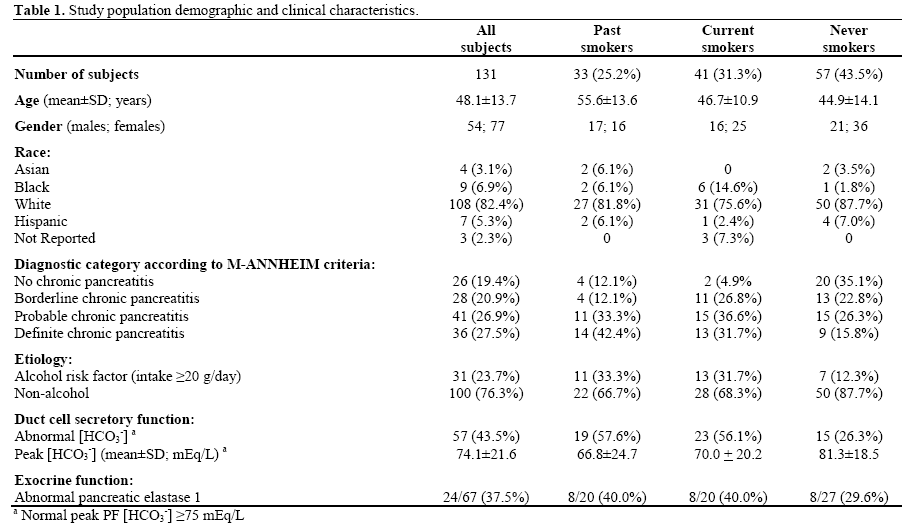
Clinical diagnosis for chronic pancreatitis was defined according to the M-ANNHEIM criteria [25]. Twenty six of the 131 subjects (19.4%) had no evidence of chronic pancreatitis; 28 (20.9%) had borderline chronic pancreatitis; 41 (26.9%) had probable chronic pancreatitis; and 36 (27.5%) had definite chronic pancreatitis. As expected, the mean peak [HCO3 -] was negatively correlated to the stage of chronic pancreatic disease according to the M-ANNHEIM diagnostic criteria and decreased from the no chronic pancreatitis group (88.3 mEq/L) to the definite chronic pancreatitis group (57.2 mEq/L) (rs=-0.579; P<0.001) (Table 2). Figure 1 shows the distribution of peak [HCO3 -] in male (Figure 1a) and female (Figure 1b) patients across all diagnostic categories in past, current and never smokers.
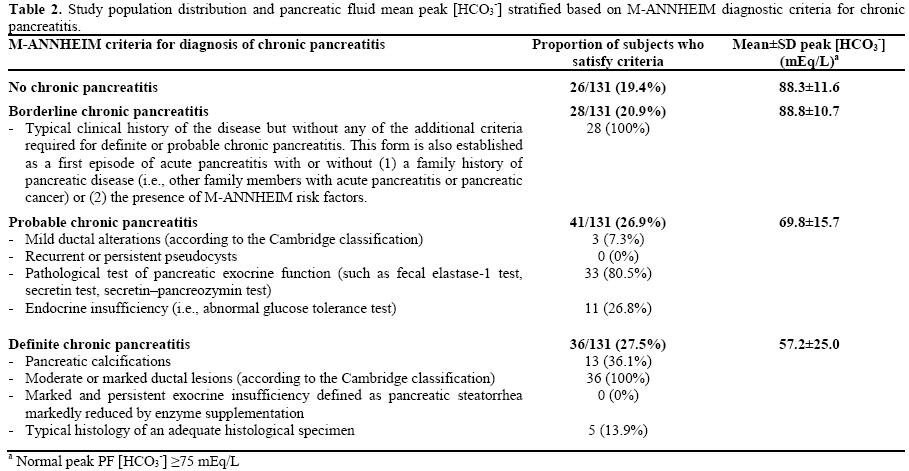
Effect of Smoking
Current and past smokers were combined to form a “Smokers” cohort. As shown in Figure 2, when compared to never smokers, the mean peak PF [HCO3 -] was significantly lower in both current smokers (P=0.005) and past smokers (P=0.005). Table 3 shows that of those 74 subjects with a history of smoking, 33 (44.6%) were past smokers, and 41 (55.4%) were current smokers at the time of function testing. Past smokers were found to be significantly older than current smokers (P=0.002). There was no statistical difference in peak [HCO3 -] between past smokers (66.8±24.7 mEq/L) and current smokers (70.0±20.2 mEq/L) (P=0.575). There was no statistical difference between the two groups with regard to gender composition and proportion of subjects with definite chronic pancreatitis, daily alcohol intake ≥20 g, abnormal peak PF [HCO3 -], and abnormal stool pancreatic elastase-1. Based on these similar characteristics, past and current smokers were combined into one “smokers cohort” for data analysis. Also shown in Figure 2, when compared to never smokers, the mean peak PF [HCO3 -] was significantly lower in the “smokers cohort” (P<0.001).
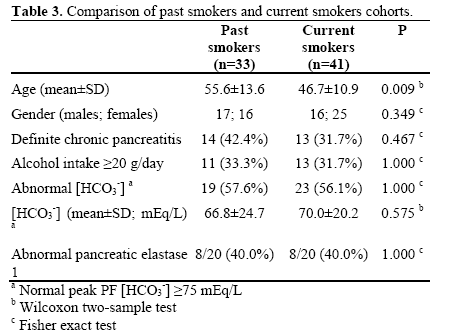
Demographic Characteristics
Demographic characteristics of the smokers cohort (past and current) compared to the never-smokers cohort are shown in Table 4. There were 74 subjects in the smokers cohort and 57 subjects in the neversmokers cohort. There was no difference in gender composition. However, the smokers cohort was significantly older (P=0.037) and as expected, had a greater proportion of subjects with definite chronic pancreatitis (P=0.010), daily alcohol intake ≥20 g (P=0.012), and abnormal peak PF [HCO3 -] (P<0.001). The mean peak PF [HCO3 -] in the smokers cohort (68.6±22.2 mEq/L) was significantly lower than that in never smokers (81.3±18.5 mEq/L) (P<0.001). There was no observed difference in the proportion of patients with abnormal stool pancreatic elastase-1 when smokers and never smokers were compared.
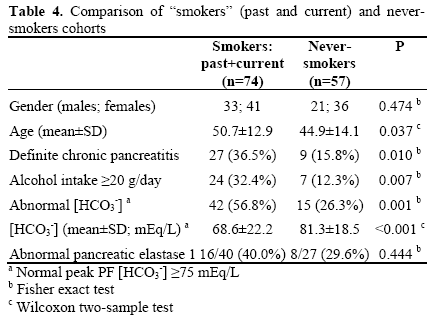
Risk of Pancreatic Duct Cell Dysfunction
Smoking (past and current), definite chronic pancreatitis, and increased alcohol intake ≥20 g/day are associated with increased risk of pancreatic duct cell dysfunction. Table 5 shows the risk ratios (RR) and their corresponding 95% confidence intervals. Cigarette smoking (RR: 2.2, 95% CI: 1.3-3.5; P<0.001), diagnosis of definite chronic pancreatitis (RR: 2.2, 95% CI: 1.6-3.2; P<0.001), and alcohol consumption ≥20 g/day (RR: 1.6, 95% CI: 1.1-2.4; P=0.033) were all associated with an increased risk of duct cell secretory dysfunction. These three factors, including age and gender were entered as covariates in a multiple logistic regression model to determine the individual contributions of each factor in predicting duct cell dysfunction. As seen in Table 6, smoking (odds ratio, OR: 3.8, 95% CI: 1.6-9.1; P=0.003) and definite chronic pancreatitis were independent predictors of duct cell dysfunction when controlling for smoking status, chronic pancreatitis, age, gender, and increased alcohol intake. Furthermore, there was no interaction between smoking plus increased alcohol intake (P=0.571) or smoking plus gender (P=0.543) in predicting duct cell dysfunction.

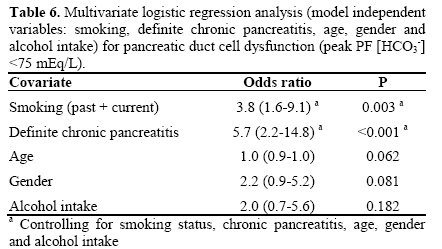
We have shown that cigarette smoking is associated with impaired pancreatic duct cell function. Specifically, the mean peak pancreatic fluid [HCO3 -] was significantly lower in both past and current smokers when compared to never smokers, and the risk of duct cell secretory dysfunction in subjects who smoked was approximately twice (RR: 2.2) the risk in never smokers. Furthermore, smoking was found to be independently associated with duct cell dysfunction (i.e., peak PF [HCO3 -] <75 mEq/L), when controlling for age, gender, increased alcohol intake, and diagnosis of chronic pancreatitis. A diagnosis of chronic pancreatitis was also independently associated with abnormal duct cell function. Often associated with chronic pancreatitis and common among cigarette smokers, increased alcohol intake was also found to be associated with elevated risk of low peak PF [HCO3 -]. However, the logistic regression model demonstrated that cigarette smoking impaired duct cell function independent of any effect of increased alcohol consumption and chronic pancreatitis. These findings add to the growing body of evidence that cigarette smoking is harmful to the human pancreas. Our results show that pancreas duct cell secretion/function is impaired in cigarette smokers.
Animal models as well as human epidemiologic and pathology studies confirm that smoking is deleterious to the pancreas in both acute and chronic pancreatitis [26, 27, 28, 29]. Continued smoking exposure has also been associated with worsening disease severity, development of parenchymal calcifications, and pancreatic carcinoma [26, 30, 31, 32, 33]. Recent elucidation of the role of inflammatory mediators (i.e. growth factors, chemokines, and cytokines) in pancreatic stellate cell physiology has improved our understanding of mechanisms leading to pancreas fibrosis and adenocarcinoma [34, 35, 36, 37]. Cigarette smoke exposure has been shown to induce expression of pro-fibrotic inflammatory mediators in animal models [28]. There is also evidence to suggest that cigarette smoking may impair pancreatic secretory function even in the absence of overt pancreatic disease [26, 38, 39, 40]. Further studies in smokers and nonsmokers are warranted. We have previously shown that our current endoscopic pancreas fluid collection method can be used to collect pancreas fluid for in depth cytokine and chemokine analyses [41]. These molecular analyses of pancreas fluid may provide insight into the mechanisms of smoking-induced injury.
There have been a limited number of human studies examining the effects of long-term cigarette smoking on pancreatic secretory function. Our findings agree with those of previous investigators that habitual smokers had significantly lower peak PF [HCO3 -] [39, 40]. A recent study also found that current cigarette smoking was independently associated with secretory dysfunction (defined as [HCO3 -] <80 mEq/L) and calcifications [26]. Human studies generally agree that smoking appears to acutely impair duct cell secretory function [38, 39, 40, 42]. Canine studies have shown that intravenous nicotine generally appeared to suppress duct cell function; however, these experiments did note variable responses in pancreatic fluid volume, secreted bicarbonate, and bicarbonate concentration [43, 44, 45].
The aforementioned physiological effects are supported by human autopsy studies and animal models demonstrating smoking-induced pancreatic inflammation and injury. Examination of human pancreata at autopsy shows that smokers are more likely to have moderate-severe pancreatic fibrosis and specifically more intralobular fibrosis [29]. In response to cigarette smoke exposure, rat models have exhibited pancreatic inflammation, focal fibrosis, acinar cell stress, and disruption of normal enzyme secretion [46, 47].
There are limitations in our study. Specifically, we were unable to quantify the duration and extent of smoking (pack-year history) and alcohol intake due to inconsistent reporting in the medical record. This is especially relevant as there is evidence to suggest that smoking increases the risk of chronic pancreatitis in a dose-dependent manner [13, 27]. We were also not able to determine precisely when former smokers ceased smoking relative to onset of symptoms, diagnosis of chronic pancreatitis, and stage of disease process. In chronic pancreatitis patients, it has been demonstrated that smoking cessation soon after onset of symptoms actually reduces the risk of developing calcifications [48]; however, secretory function before and after smoking cessation has not been compared. Contrary to our findings, previous investigators have found that former smoking was not a predictor of chronic pancreatitis [26]. However, it should be noted that in addition to limited information about smoking intensity and timing of smoking cessation, we were unable to confirm patients’ reports of continuous abstinence from cigarette smoking. A significant number of false reports regarding smoking status would certainly confound any comparisons between the groups. Lastly, the generalizability of our study was limited by a referral bias inherent to the study sample. This patient sample was drawn from subjects referred to the Brigham and Women’s Hospital Center for Pancreatic Disease and does not represent the overall general population. For example, the prevalence of definite chronic pancreatitis (16%) and abnormally low peak bicarbonate concentrations (26%) in our neversmoker cohort was greater than would be expected in the general population [49].
In conclusion, cigarette smoking is independently associated with impaired pancreatic duct cell secretory function, regardless of age, gender, alcohol intake, and the presence of chronic pancreatitis. Further investigation is needed to determine the impact of both smoking dose exposure and smoking cessation on duct cell function. Our findings join a growing body of evidence that suggests smoking cessation is likely vital to the prevention and management of chronic pancreatitis. Smoking cessation should be encouraged early in disease management in hopes of retarding deleterious effects on the pancreas. But more importantly, endoscopic collection and in depth analysis of pancreas fluid may open new areas of research for better understanding the mechanisms of smoking induce pancreatic injury [50].
American College of Gastroenterology Clinical Research Grant (2007 DL Conwell). Center for Pancreatic Disease, Brigham and Women’s Hospital (PA Banks)
American College of Gastroenterology Clinical Research Grant (2007, DL Conwell). Center for Pancreatic Disease Research Fund, Brigham and Women’s Hospital (PA Banks). Translational Research Fund in Pancreatic Disease, Brigham and Women’s Hospital (DL Conwell, PA Banks).
None